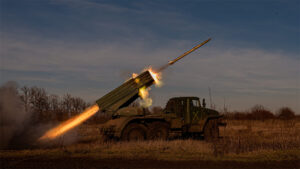I’m going to do something today that I normally try to avoid: commenting on a political statement that may well not turn into policy. It’s a big, busy world with a lot going on on even a slow day, and American President Donald Trump likes to talk and tweet a lot. If I philosophically waxed on the potential geopolitical implications of everything Trump ever said (or was said about him or near him), I’d never have time to shower.
Yet of late Trump has been connecting more of his rhetoric to actual policy (for example, on trade), and his ongoing cabinet overhaul is installing personalities with reputations for boldness and effectiveness (for example, the incoming National Security Adviser John Bolton). Me noting such improvements in delivery is not the same thing as me personally endorsing those policies or persons, but I’m in the job of calling it as I see it and I avoid lobbying for any particular policy.
Which means I’m about to do something else I normally try to avoid: calling a mistake a mistake.
At a gathering of Baltic presidents earlier this week the American president indicated he planned to deploy the U.S. military to the border until such time as Congress appropriates the required funding for a large, meaningful border barrier. On April 4, the Homeland Security Secretary indicated that the Trump White House was already coordinating with several states to send National Guard troops to the border, perhaps immediately.
I’ll leave it to more military-minded folks to parse the differences in significance between a regular military deployment and the Guard, but regardless, from my point of view it would be a colossal mistake on at least two levels.
First, far from reducing illegal migration, any meaningful wall effort will drastically increasethe ability of illegal migrants to cross the border while also criminalizing the entire border region. The Sonoran and Chihuahuan Deserts that form the bulk of the American-Mexican border regions are among the most dangerous, desolate regions of the planet. That makes it a good border – it is hard to cross. Would-be migrants have to make crossings in the deep desert. Dangerous, desolate areas with no towns also have another defining characteristic: no roads. Anyone who crosses the deep desert largely has to do so on foot, and a great many die trying.
Areas with no roads cannot support other signs of civilization: post offices, schools, hospitals, gas stations…or walls. The first thing that would need to be done to facilitate the construction of a meaningful border wall would be to build service roads across the desert at at least 40 points in order to enable heavy construction vehicles to reach the border in the first place. At least one road would then need to parallel the wall across the entire 2000 miles of would-be border wall. Put simply, the preparatory effort of building a barrier to stop illegal migrants would eliminate the biggest current barriers that hinder illegal migrants: the region’s natural hostility, remoteness and lack of infrastructure.
(Incidentally, narcotics also flow more heavily along routes with good infrastructure, so the wall would likely double down on one of America’s most pressing social/law & order issues in addition to exacerbating the migration question.)
Even that assumes the wall actually stops migrants. It wouldn’t. A great comparison is the world’s second-most hermetically sealed border barrier: the Gaza Wall that keeps the Palestinians bottled up in the Gaza Strip. (The Korean DMZ, with its miles-thick fields of landmines, comes in first.) The Gaza Wall is over 30 feet high, made of solid concrete, and the Israeli Army has standing shoot-on-sight orders for anyone brave enough to try overtopping it. Yet the Gaza Wall is so riddled with tunnels that the Gazans regularly get everything from construction materials to consumer electronics to foodstuffs to live animals to missiles to wedding parties to fast food deliveries on a daily basis.
The point isn’t just that the Gaza Wall is porous, but that Gaza’s under-wall traffic is fairly regular – items and people go back and forth often. A U.S.-Mexico border wall would need to block irregular traffic because the illegal migrants only need to cross once. That requires a much more intense security regimen than exists in Gaza, which now means so expanding the border infrastructure that the United States has a moderate number of border agents every few miles. Having only 30 people on station every four miles (a woefully inadequate number considering the task’s scale) at any given time adds up to roughly 60,000 security staff – not counting support personnel or the sort of expanded infrastructure required to support such a large number of people along such a long logistical chain in such a remote area.
It’s worse than it sounds by far. Any border defined by an ineffective barrier and large, determined population movements is one in which various elements will conspire to provide clandestine crossing capacity that expressly avoids law enforcement. That not only generates a culture of criminality, but a whole industry based upon circumventing the barrier. Considering the Mexican cartels already have deep pockets courtesy of their narcotics smuggling, and already hold respectable market share in the smuggling of people, adding a wall would provide the cartels with the perfect environment to use cash and guns to criminalize America’s border towns and the border force itself.
My second major objection is that border patrol is the last thing the U.S. military should be involved in. Militaries exist to fight wars, and while the nature of conflict is certainly evolving in an era of irregular conflicts, drones and cyberspace, hunting down illegal migrants remains completely alien to the military’s training and culture. America’s military is awesomely powerful because its Abrams tanks and Nimitz carriers and Longbow helicopters are terrifyingly effective at blowing shit up. In a high labor cost country like the United States, a military’s business is all about using very expensive equipment to blow up other folks’ expensive equipment, preferably from over-the-horizon so that retaliation is never an option.
Interdicting illegal migrants requires not just getting up close and personal, but capturingthe would-be migrants, shipping them somewhere for processing, and then somehow dumping them back across the border… and likely doing it all over again the next day. I have the utmost respect for the American military’s ability to adapt and evolve, but border duty means taking a high-dollar, high-skill asset and using it for low-dollar, low-skill tasks.
Even that assumes the military could do the job well. It could not. If there is something the military has learned after 15 years of wars in Afghanistan and Iraq, it is that it hates interfacing with civilians. The military is trained to, in a nutshell, kill people – not build things. But even during the Iraqi occupation lethality was a useful tool because there was an insurgency afoot, packed with imported radicals. That would not happen on the border. Lethality isn’t useful unless American society takes a hideously dark path and simply shoots everyone in the border region with a tan. Or if you prefer, the Army could separate the illegals from the citizens first and, what? Execute the illegals by firing squad? Any military that does either of those things becomes a force that American citizens would (and should) be afraid of.
Even that assumes meaningful patrols are possible. Were the U.S. Army assigned to this task it would be taking on the greatest geographic reach of any American Army effort everin the most hostile natural environment the Army has ever been deployed in on a mission for which “victory” would never be possible because the border isn’t a war.
There are other reasons barricades and troops are not the right solutions. A meaningful wall’s impact on trade would easily trigger a U.S. recession across the United States with Texas getting hit the hardest. It would cause a multi-year depression in Mexico that would so destabilize the country economically as to guarantee sustained increases of illegal migrants to the United States. Current thoughts of militarizing and attempting to secure Mexico’s northern border would actually cause the problems they purport to address.
It would also cheese off the government that is most critical to actually stemming migrant levels in the first place: Mexico. Keep in mind that net migration from Mexico to the United States has been negative for nearly a decade. Most of the illegals that enter the United States from the south are not from Mexico, but instead from the half dozen Central American countries. If interdiction is the goal, the best place to do so is at Mexico’s southern border which is both far shorter and easier to fortify than its northern border.
That sort of interdiction requires a relationship between Washington and Mexico City characterized by communication, cooperation and a degree of trust – not sending the Army to the border. Instead, the bilateral political relationship is now so poisoned that it will very likely lead to the election of the Mexican equivalent of Bernie Sanders – one Andres Manuel López Obrador – who has campaigned on a promise to cease all cooperation with the Americans.








